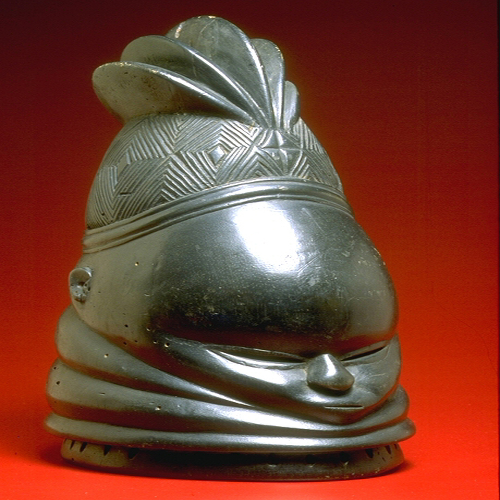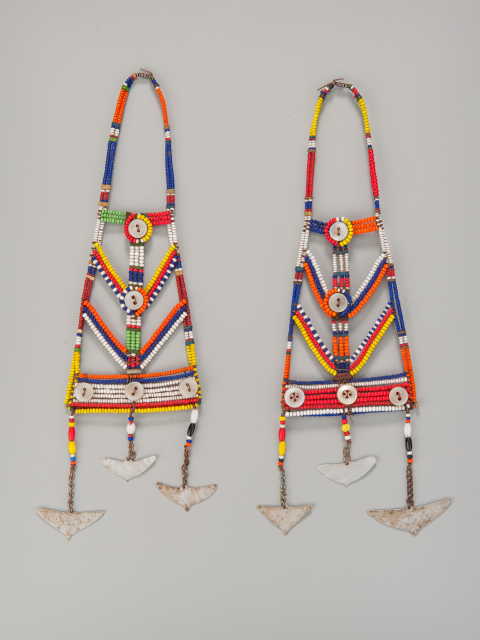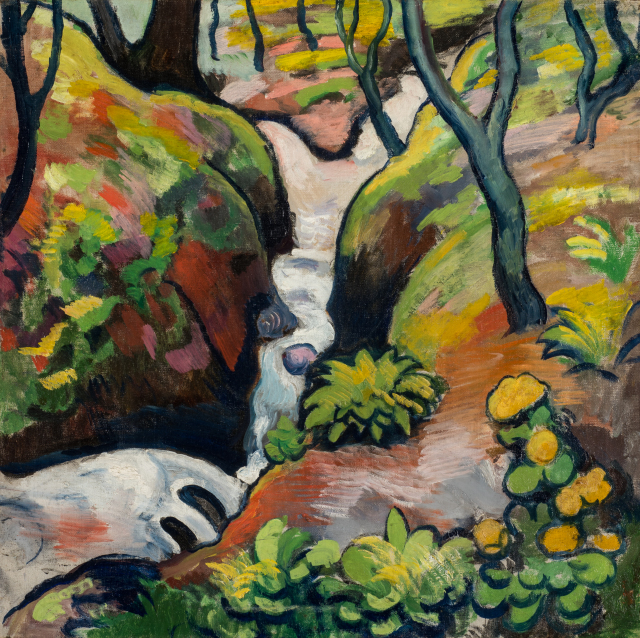Currently On View
This pathway provides an introduction to what's on view in each of the galleries.
Welcome to the Eskenazi Museum of Art
Whether this is your first visit or your hundredth, we hope you enjoy your visit.
Click 'See more details' for our Gallery Guidelines.
Spend quality time here.
Please be respectful of every person's museum experience.
Photo and videos encouraged! No flash, tripods, or selfie sticks.
Sketching encouraged! Pencils only, drawing boards up to 24 x 30 inches are okay.
Help us keep the art safe.
Do not touch the artwork. Keep a safe distance between you and the artwork.
No food or drink in the galleries. Enjoy refreshments outside on the café terrace.
No backpacks, bulky items, or large coats. Bags up to 12 x 18 inches are welcome.
No wet items or umbrellas. Tables are available outside each gallery.
Service animals are welcome! Please leave your pets at home.
Bring the family.
We love strollers. When carrying small children, please keep them in front of you.
Bottle and breastfeeding are welcome throughout the museum. The Wellness Room on the Mezzanine is also available for your use.
Please accompany children at all times.
3rd Floor | Arts of Africa, Oceania, and Indigenous Art of the Americas | Raymond and Laura Wielgus Gallery
This gallery displays ancient to contemporary artworks from three collection areas associated with different world regions comprised of hundreds of cultures and languages. The regions represented in this gallery are spread across four continents and the planet’s largest ocean. This collection spans more than 3,000 years.
Arts of Africa represents visual art practices from across the continent, with a focus on sub-Saharan Africa. The Eskenazi Museum of Art is known internationally for this African art collection.
Arts of Oceania includes artworks from places in the South Pacific associated with the regions of Polynesia, Melanesia, and Micronesia.
Indigenous Arts of the Americas is geographically broad in scope and includes artworks from Ancient Mesoamerica, Central and South America, and Native American arts in North America.
Historically, museums have presented these regions together because Europeans interpreted, or more accurately misinterpreted, artworks associated with these cultures and perceived few distinctions between them. Consequently, this practice, which began in the fifteenth century and was emphasized during colonial-era collecting in the nineteenth century, tells us more about Europeans than it does about the people from these cultures. As you explore this gallery, we encourage you to think about these contrasting perspectives and histories of representation.
The historical encounters of Europeans exploring foreign lands relates to early collecting practices in Europe and the United States. The museum prioritizes provenance research to better understand ownership histories of artwork in these three collections, specifically how they traveled from their places of origin to the art market and Bloomington. Outcomes of that ongoing research will be reflected in revisions to individual artwork labels both in the gallery and on the museum's website.
Saturday, August 26, 2023, 10:00 AM – Sunday, February 18, 2024, 5:00 PM
This focus exhibition explores the transmission of knowledge through the textile legacies of Central and South America to show the powerful role of cloth to transfer cultural wisdom across generations. It brings attention to cloths made in the 20th century, including mola, huipil, and poncho. These textiles represent practices that continue to be actively created, used, and preserved by communities for future generations. The historical legacies of these textiles testify to the contemporary vitality and resilience of the communities they originate from in Central and South America.
This focus exhibition is curated by museum graduate assistant Angiee Liliana Rocha Parra, under the mentorship of Allison J. Martino, Laura and Raymond Wielgus Curator of the Arts of Africa, Oceania, and Indigenous Art of the Americas.
3rd Floor | Adam Magyar: Matter | Time-based Media Gallery
Saturday, February 10, 2024, 10:00 AM – ,
Time-based Media Gallery, Third Floor
Full HD video with sound, 9 min 40 seconds
Time is among the most fundamental conditions of human existence, yet also perhaps the most elusive. In still forms of art like painting and photography, the passage of time is often represented symbolically, as an hourglass, withering flowers, rotting fruit, or a human skull. In film, time can be represented more directly by movement and sound. Hungarian-born video artist and photographer Adam Magyar has studied the relationship between time and moving images extensively. In his work, he has developed custom cameras to capture subway cars speeding into stations at 1300 frames per second, 54 times the standard cinematic framerate of 24 frames per second. In another project, he photographed high-traffic public areas repeatedly from a fixed overhead position, overlaying the images to produce composite pictures of impossibly dense human crowds.
His newest work Matter expands on this practice, focusing on the spatial dimension of the moving image over time. Fixing a camera inconspicuously in public spaces throughout his worldwide travels, Magyar captured hours of human foot traffic, layering the video recordings upon each other and replacing the urban cacophony with a solemn, meditative soundtrack. The resulting images depict the ghostly traces of dense human presence in otherwise still environments, shifting the focus to the spaces that remain stable as life passes by. Matter can be read as a contemporary memento mori, a reminder of the destructive potential of our age of climate change and global conflict. Conversely, the video might be understood as a peaceful tribute to humankind’s minor role in the grand scheme of the universe, our moment being but a blink in the eye of time.
Adam Magyar (born 1972) is a Berlin-based Hungarian photographer and video artist captivated by time. His process is a symbiosis between technology and creative instinct. He is fascinated by the flow and the endless stream of life in the world’s biggest mega-cities.
3rd Floor | Magic Ledger: The Drawings of Saul Steinberg | Rhonda and Anthony Moravec Gallery, Center for Prints, Drawings, and Photographs
Saturday, January 27, 2024, 10:00 AM – Sunday, June 02, 2024, 5:00 PM
Rhonda and Anthony Moravec Gallery, Center for Prints, Drawings, and Photographs, Third Floor
Saul Steinberg (American, 1914–1999) brought a modernist aesthetic and cosmopolitan sophistication to his gallery art and commercial work—including eighty-five covers and more than twelve hundred internal drawings for The New Yorker magazine—endearing him to many artists, writers, and popular audiences of his era. In 1965, noted author Vladimir Nabokov wrote to the artist, calling his collection of drawings The New World a “magic ledger” that reflected Steinberg’s skill at combining a fantastic imagination with shrewd observation. As Steinberg said, “The purpose of drawing is to make people feel that there is something else beyond the perception. That is essentially what I am playing with—the voyage between perception and understanding.” The works in this exhibition explore Steinberg’s travels, influences, and his diverse range of subjects and drawing techniques. Some of the drawings relate to his many magazine publications, others were included in his book compilations, but most are simply independent drawings of his favorite motifs, such as women in fancy hats, cowboys, cats, cars, soldiers, and architecture. A Romanian-born Jew who had escaped antisemitism in his homeland and Italy, Steinberg brought an outsider’s perspective to the people, places, and politics of postwar Europe and the United States. His witty—and often slightly satirical—studies manage to bring a smile to your face, while at the same time stimulating your mind.
The exhibition includes forty-three unique works, selected from the recent gift of sixty-five drawings, twenty-one prints, and an annotated catalogue from The Saul Steinberg Foundation and six works acquired by the museum in the 1970s. It is co-curated by Nan Brewer, the Eskenazi Museum of Art’s Lucienne M. Glaubinger Curator of Works on Paper, and Andrei Molotiu, senior lecturer in art history, and is based on research conducted by students in the IU course "Curating Saul Steinberg: From the Pages of the New Yorker to the Gallery Wall" (A490/580): undergraduates Meredith Cox, Kristin Davis, Hope Gerber, Morgan Hardin, Erin Hardy, Shannon Hocker, Katama Murray, Cody Rosenberg, Sasha Sears, Samantha Stroud, and Allie Tucker and graduate students Natalie Beglin, Caitlyn Clark, Kerrigan Clark, and Katama Murray. The advice and expertise of Shelia Schwartz, Research & Archives Director at the Saul Steinberg Foundation, are also deeply appreciated.
The exhibition is generously supported by John and Rita Grunwald, Susan C. Thrasher, and The Greig Family Fund.
2nd Floor | Ancient, Asian, and Islamic Art
Located on the second floor, this gallery includes ancient art as well as Asian & Islamic art.
The museum’s Asian and Islamic art collection spans 4,000 years. Asia is the longtime home of most of the human population. Guided by shared characteristics, the collection is organized into five major groups determined by geographic region and historical or cultural affinities, although each country has its distinct cultural heritage. The five areas on view include East Asia, Southeast Asia, South Asia, and the Islamic collection.
The ancient art collection is from the vast region surrounding the Mediterranean Sea and the Near East—an area that incorporates and interconnects three continents: Africa, Asia, and Europe. It invites museum visitors to look into a past world very different from our own, yet one that has continued to influence the development of ideas through modern times. This collection includes objects dating from 30,000 BCE through 1000 CE, and addresses themes like religious ritual, funerary practices, public ceremony, and daily life. Our collection of ancient art contains works from many cultures, including Sumerian, Assyrian, Egyptian, Persian, Minoan, Mycenaean, Etruscan, Greek, and Roman.
This student-curated focus exhibition explores the rich imagery of vase painting in ancient Greece. It is being developed by IU students in the Arts and Sciences Undergraduate Research Experience (ASURE) program, with the mentorship of Dr. Julie Van Voorhis and Ancient Art curator Juliet Graver Istrabadi.
The Arts and Sciences Undergraduate Research Experience supports courses that introduce students to hands-on research as early as possible in their academic careers. ASURE classes emphasize mentorship and project-based learning.
1st Floor | European and American Art, Modern and Contemporary | Eskenazi Gallery
Sunday, September 18, 2022, 12:00 PM – Saturday, September 30, 2023, 5:00 PM
Located on the first floor, the Eskenazi Gallery of Modern and Contemporary European and American art features a stellar collection of work from the early 1900s to the present. Strengths include German Expressionism, modernist sculpture, Dada objects (including the only complete set of Marcel Duchamp’s iconic Readymades in the United States), and post–World War II abstract painting. Another highlight is Stuart Davis’s mural Swing Landscape, one of the most significant American paintings of the twentieth century.
More information about European paintings and sculptures in the collection can be found on our Nazi-Era Provenance Research Project.
The career of painter Judith Rothschild (1921–1993) spanned the breadth of the twentieth century. Rothschild graduated from Wellesley College in 1943 and studied art at the Cranbrook Academy of Art and the Arts Students League in Manhattan. Her first solo show was held in December 1945 at Jane Street Gallery in New York City, where she was a member of the artists’ collective that included Nell Blaine, Ida Fischer, Jane Freilicher, Louisa Matthíasdóttir, and Larry Rivers. The early half of her career was characterized by colorful, Cubist abstraction influenced especially by her teachers Hans Hoffman and Karl Knaths. In the 1970s, she began incorporating new materials and techniques into her work, developing relief paintings with foam core and bright pigments in undulating, curvilinear shapes. The works in this exhibition represent her midcareer and later output, where Cubist tendencies took on Fauvist colors and Matisse-like forms. Throughout her five decades of painting, Rothschild remained true to her modernist foundations while cohesively incorporating new methods, materials, and ideas.
1st Floor | European and American Art, Medieval to 1900 | Fortune Gallery
Located on the first floor, the Jane Fortune Gallery of European and American Art, Medieval to 1900, offers an expansive survey of western art, with particular strengths in Italian Renaissance and nineteenth-century landscape and Impressionist painting. A wide range of objects, including paintings, sculptures, altarpieces, Jewish and Christian liturgical arts, and decorative arts, offer multiple perspectives on European history.
More information about European paintings and sculptures in the collection can be found on our Nazi-Era Provenance Research Project.
The term "Renaissance" describes a chronological period (primarily the fifteenth and sixteenth centuries) and an artistic style particularly associated with the early modern Italian states. Florence and Tuscany are generally held as the pinnacle of artistic creation during the Italian Renaissance. With artists like Giotto, Botticelli, and Michelangelo working primarily in Florence it is understandable that the Tuscan city retains such notoriety.
Florence's early and continued claim to excellence is due in part to Giorgio Vasari's (1511-74) biographical work Lives of the Artists. First published in 1550, it established an artistic hierarchy that progressed from the early to the High Renaissance and reached perfection with Michelangelo.
Milan and Venice were also acknowledged artistic centers and home to famed artists like Leonardo da Vinci and Titian. Even though many artists are associated with a particular city, travel and competition were important during the Renaissance, and encouraged communication between artists, if not a cohesion of styles.
This collection of paintings features artists primarily from Northern Italian states such as Milan, Lombardy, and Venice. While these artists and workshops are not part of the dominant canon of Renaissance art, they represent an enriched picture of artistic practice during the period and demonstrate a wealth of creativity and production beyond the narrower definition of the canon.
Suggested Pathways

Pairing Art and Music
Combine sight and sound for a unique imaginative experience.

Clothing and Personal Adornment
This path considers how and why human beings create art for personal use. Clothing, jewelry, cosmetics, hair styles and hair accessories, and other objects added to the body are personal statements that also reflect shared values within societies.

Mindfulness
The series of audio entries on this pathway focus on the practice of mindfulness. Mindfulness is a way of observing and accepting the present moment. It can be especially effective when used while experiencing works of art.


